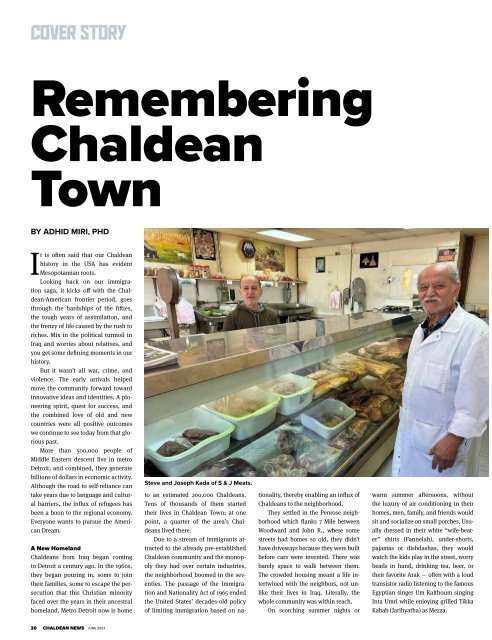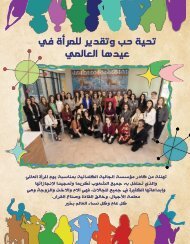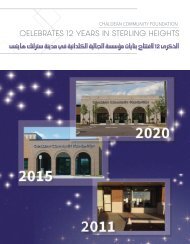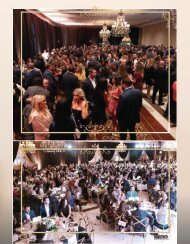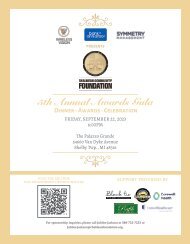You also want an ePaper? Increase the reach of your titles
YUMPU automatically turns print PDFs into web optimized ePapers that Google loves.
COVER STORY<br />
Remembering<br />
Chaldean<br />
Town<br />
BY ADHID MIRI, PHD<br />
It is often said that our Chaldean<br />
history in the USA has evident<br />
Mesopotamian roots.<br />
Looking back on our immigration<br />
saga, it kicks off with the Chaldean-American<br />
frontier period, goes<br />
through the hardships of the fifties,<br />
the tough years of assimilation, and<br />
the frenzy of life caused by the rush to<br />
riches. Mix in the political turmoil in<br />
Iraq and worries about relatives, and<br />
you get some defining moments in our<br />
history.<br />
But it wasn’t all war, crime, and<br />
violence. The early arrivals helped<br />
move the community forward toward<br />
innovative ideas and identities. A pioneering<br />
spirit, quest for success, and<br />
the combined love of old and new<br />
countries were all positive outcomes<br />
we continue to see today from that glorious<br />
past.<br />
More than 500,000 people of<br />
Middle Eastern descent live in metro<br />
Detroit, and combined, they generate<br />
billions of dollars in economic activity.<br />
Although the road to self-reliance can<br />
take years due to language and cultural<br />
barriers, the influx of refugees has<br />
been a boon to the regional economy.<br />
Everyone wants to pursue the American<br />
Dream.<br />
A New Homeland<br />
Chaldeans from Iraq began coming<br />
to Detroit a century ago. In the 1960s,<br />
they began pouring in, some to join<br />
their families, some to escape the persecution<br />
that this Christian minority<br />
faced over the years in their ancestral<br />
homeland. Metro Detroit now is home<br />
Steve and Joseph Kada of S & J Meats.<br />
to an estimated 200,000 Chaldeans.<br />
Tens of thousands of them started<br />
their lives in Chaldean Town; at one<br />
point, a quarter of the area’s Chaldeans<br />
lived there.<br />
Due to a stream of immigrants attracted<br />
to the already pre-established<br />
Chaldean community and the monopoly<br />
they had over certain industries,<br />
the neighborhood boomed in the seventies.<br />
The passage of the Immigration<br />
and Nationality Act of 1965 ended<br />
the United States’ decades-old policy<br />
of limiting immigration based on nationality,<br />
thereby enabling an influx of<br />
Chaldeans to the neighborhood.<br />
They settled in the Penrose neighborhood<br />
which flanks 7 Mile between<br />
Woodward and John R., where some<br />
streets had homes so old, they didn’t<br />
have driveways because they were built<br />
before cars were invented. There was<br />
barely space to walk between them.<br />
The crowded housing meant a life intertwined<br />
with the neighbors, not unlike<br />
their lives in Iraq. Literally, the<br />
whole community was within reach.<br />
On scorching summer nights or<br />
warm summer afternoons, without<br />
the luxury of air conditioning in their<br />
homes, men, family, and friends would<br />
sit and socialize on small porches. Usually<br />
dressed in their white “wife-beater”<br />
shirts (Fannelah), under-shorts,<br />
pajamas or dishdashas, they would<br />
watch the kids play in the street, worry<br />
beads in hand, drinking tea, beer, or<br />
their favorite Arak — often with a loud<br />
transistor radio listening to the famous<br />
Egyptian singer Um Kalthoum singing<br />
Inta Umri while enjoying grilled Tikka<br />
Kabab (Jarihyatha) as Mezza.<br />
20 CHALDEAN NEWS <strong>JUNE</strong> <strong>2023</strong>


